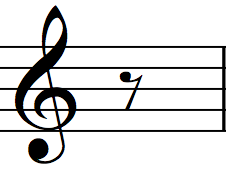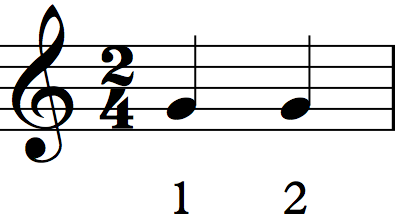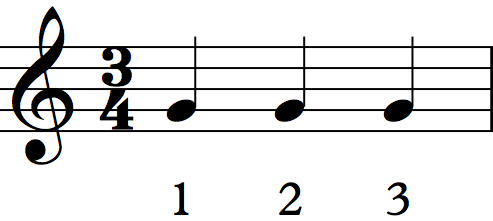2 More Open Strings, Rhythms & Time Signatures
Introduction
In this unit you will learn three more notes, eighth-note rhythms and two more time signatures. We will continue to follow the same procedure in which you learn symbols and then sight-read them in the Let’s Play section below. Let’s begin!
Notations
Notes
The Note ‘E’
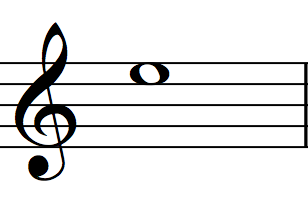
‘E’ is in the top space of the staff. It is played as the first string open.
The Note ‘G’
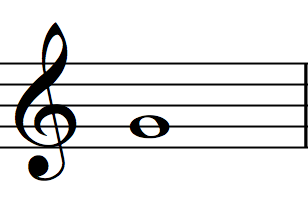
‘G’ is on the second line of the staff. It is played as the third string open.
The Note ‘A’
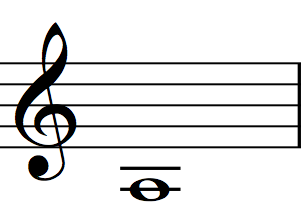
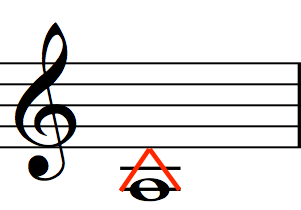
‘A’ is on the leger second line. It is played as the fifth string open. To remember the pitch A, imagine two diagonal lines that touch at the top and run tangentially along the note head. Notice how it makes an upper case letter A.
Rhythms
An eighth note sustains for half of a beat. The eighth note can be written in two ways: either with a beam or a flag.
Eighth Notes Beamed
When eighth notes are grouped, each note consists of a note head that is filled in, a stem and a beam. Notice that the beam connects two eighth notes.
Eighth Note Flagged
When eighth notes are not grouped each note contains a flag(instead of a beam).
Eighth Rest
The eighth rest creates silence for half of a beat. It consists of a diagonal line with a small flag.
How To Count Eighth Notes
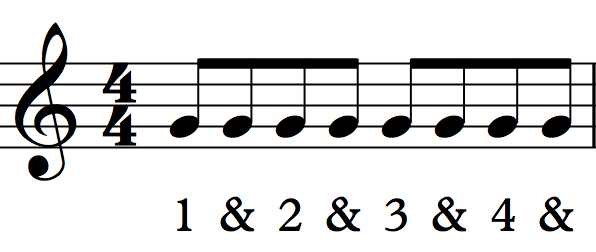
The first half of the beat receives a number that represents the beat’s placement in the measure. The second half of the beat receives the word and (represented by the symbol &). Whenever music contains eighth-note rhythms I suggest you count with ‘&’ throughout the entire piece, even when you encounter quarter, half and whole-note rhythms. This will help you maintain a steady beat.
Time Signatures & Meter
2/4 Time Signature
The 2/4 time signature = 2 x 1/4 notes per measure. In other words, there are 2 quarter notes per measure. When measures contain two beat groupings, musicians refer to the music as being in duple meter. It is important to allow yourself to feel the groupings of twos and accent certain sounds accordingly.
3/4 Time Signature
The 3/4 time signature = 3 x 1/4 notes per measure. In other words, there are 3 quarter notes per measure. When measures contain three beat groupings, musicians refer to the music as being in triple meter. It is important to allow yourself to feel the groupings of threes and accent certain sounds accordingly. By the way, 4/4 time is considered quadruple meter because the measures contain four beat groupings.
Let’s Play |
Sight-Reading Tips
Rhythmic Feel
A recent study suggests that sight-reading improves when musicians focus on the feel of the meter, instead of individual beats.[1] To play with the feel of the meter, start by emphasizing the first beat of each measure more than the others.
If you want to learn more about time signatures and meter please visit: http://openmusictheory.com/meter.html
Patterns
For the last few decades, music educators have studied a phenomenon called chunking. Chunking is when musicians visually perceive patterns rather than individual notes. It turns out that skilled sight-readers chunk.[2]
You all chunk when you read words. Most of you see the letters d-o-g and immediately say dog. This is an example of chunking. But, remember what it was like when you had to sound out each individual letter: dee-oh-gee? That is pre-chunking.
The exercises under the heading Let’s Play Patterns are designed to help you process individual notes into patterns as quickly as possible. It is important to trust your instincts. I would rather you attempt to play a pattern and make mistakes than to not try at all.
Checklist for Sight-Reading
- Count the beats out loud (including the &).
- Keep going (even if you make a mistake).
- Maintain your best playing posture.
- Look at the score, not your hands.
- Play with the feel of the meter.
- Play patterns instead of individual notes (AKA chunk).
- Have fun!
Let’s Play Rhythms |
Attitude Tip
Do not fear mistakes, there are none. –Miles Davis
Exercise 2.1: Score
Exercise 2.1: Audio
Exercise 2.2: Score
Exercise 2.2: Audio
The next exercise will have a two beat count-in because there is a 2/4 time signature at the beginning of the score. Since the smallest rhythmic value in Ex. 2.3 is an eighth note, you need to count 1&2&. From now on, please remember that the count-in always corresponds with the time signature.
Exercise 2.3: Score
Exercise 2.3: Audio
The next two exercises will have a three beat count-in because there is a 3/4 time signature at the beginning of the each score. Since the smallest rhythmic value in Ex. 2.4 is a quarter note, you simply need to count 123. However, since the smallest rhythmic value in Ex. 2.5 is an eighth note, you need to count 1&2&3&.
Exercise 2.4: Score
Exercise 2.4: Audio
Exercise 2.5: Score
Exercise 2.5: Audio
Let’s Play Patterns |
Attitude Tip
Only those who will risk going too far can possibly find out how far one can go. –T.S. Eliot
The Let’s Play Patterns category will help you develop the ability to chunk. The exercises in this category are presented as guitar duets.
Exercise 2.6: Score
Exercise 2.6: Audio
Exercise 2.7: Score
Exercise 2.7: Audio
Exercise 2.8: Score
Exercise 2.8: Audio
Let’s Play Duets |
Attitude Tip
The day you decide to do it is your lucky day. –Japanese proverb
The exercises in this series are progressive and cumulative. They contain information you learned in this unit as well as previous units. As a result, you may need to review the symbols you learned in Unit 1.
Exercise 2.9: Score
Exercise 2.9: Audio
Exercise 2.10: Score
Exercise 2.10: Audio
The Quiet House by Frank Bartscheck II: Score
The Quiet House: Audio
Congratulations!
You have completed this unit! If you kept up with the beat and accurately played approximately 70% of the pitches and rhythms, you are ready for the next unit. Feel free to repeat the exercises. However, do not play them so often that you memorize them. Once you memorize the notation, you are no longer developing the skill of sight-reading.
- Penttinen, Marjaana and Huovinen, Erkki. "The Early Development of Sight-Reading Skills in Adulthood: A Study of Eye Movements." Journal of Research in Music Education, vol. 59, no. 2, 2011, pp. 196-220. ↵
- Gromko, Joyce Eastlund. "Predictors of Music Sight-Reading Ability in High School Wind Players." Journal of Research in Music Education, vol. 52, no. 1, 2004, pp. 6-15. ↵



